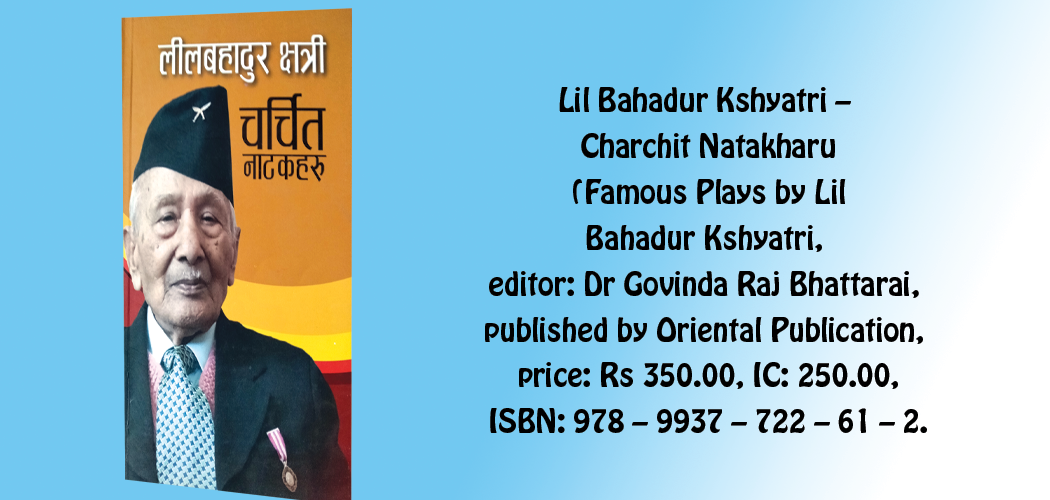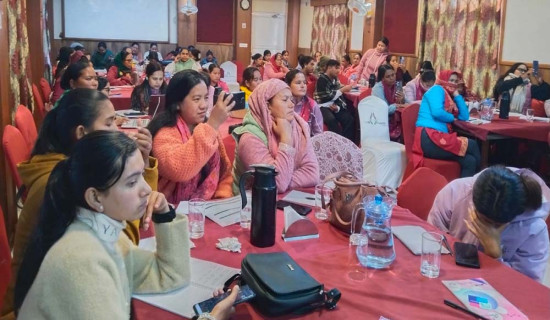- Thursday, 25 December 2025
Rebirth Of Forgotten Dramas Of Lil Bahadur
Gandhi Raj Kafle
Lil Bahadur Kshyatri flew to Delhi from Assam and received the prestigious national award Padmashree there from India’s president and returned to his home at the end of 2021. He is now 91 years old. This honour from the Indian government, which the nonagenarian litterateur received, is for his contributions to the Nepali language and literature.
In this regard, it would be appropriate to remember Kshyatri as a litterateur, who has also been widely known for ‘thin book with powerful theme’ since he wrote a highly popular small novel named “Basain" in the Nepali language. Thus, Lil Bahadur’s contributions to Nepali literature and language are non-stop and it is hard to measure his selfless creative devotion.
However, we have this under review book entitled “Charchit Natakharu by Lil Bahadur Kshyatri", which has come out under the editorship of Dr Govinda Raj Bhattarai. For readers and writers who know Lil’s personality and creativity, the curiosity is there: Why has only a collection of various dramas, not an analytical presentation of novels or other literary creations of nonagenarian Lil been published?
Nothing more needs to be added here because Dr Bhattarai has written a 28-page long critical appreciation to justify the relevance of documenting the texts of various dramas which Lil wrote for stage shows in the distant past.
Almost forgotten and lost texts have come into book form. And it has become easier now for new generations of Nepali readers to remember and read dramas, which today's Padmashree winner Lil wrote to deliver powerful messages from that time to generate awareness.
That was the time of dramas and the role of this genre was to provide entertainment and awareness. Litterateur Lil’s heydays during which he wrote these dramas remind us of famous playwright Bala Krishna Sama and many others who were engaged to help people toward political awakening in Nepal. So, this is an important publication because it helps to know how meaningfully we in Nepal and Nepali speaking people in India had been attached to entertainment and awareness through the medium of messages of various drama writings and their displays on stage.
This book commences with a few words both in print form and in the own handwriting of Lil Bahadur Kshyatri recovered through email. Then begins a long prologue by Dr Bhattarai entitled “Lilbahadur Kshyatrika Natak Sankalanko Pristhabhuumi Ra Prakashan Sandarva” (Background of collection of dramas by Lil Bahadur Kshyatri and relevance of its publication), where he praises Kshyatri saying, ‘he is a peak and founder of Nepali novel’.
Migration is a pressing reality in our context. Dr Bhattarai has focused this fact in the context of Lil’s “Basain" Nepali novel in these words: '…If we talk about the origin and preliminary expansion of Nepali literature, we find no differences in themes and the life of creators.
That is why we praise Basain – people from here went there and people from there came here. Benaras, Dehradun, Darjeeling, Manipur and Shillong are the places that kept the light of our language burning.'
Structurally speaking, the editor has divided this 238-page book into four chapters. The first and second chapters include dramas with social themes.
In the third chapter, there are three Aekankis (one-act-plays) of Lil Bahadur Kshyatri. Similarly, chapter four contains Radio Rupakharu (radio dramas).
The making of chapters of this book is based on themes of Social messages, which had always been the major aim for the public in those days. Similarly, one-act plays and radio dramas were considered to be highly popular and effective means of both communication and entertainment during that time. But, one thing, when we remember various dramas written by Lil, we must also remember connecting values of such literary activities in places of Assam, where Lil is living and here in Nepal also.
Now, to talk about the importance of this book, we should try to see literary development from a historical perspective. Lil Bahadur Kshyatri, no doubt, is a Nepali speaking and writing literary personality of India. Today India has honoured him with the Padmashree award recognising his talent and contributions to literature through the medium of the Nepali language. This is a pride of literary domain here in Nepal too.
But, this pride will not be meaningful, if we forget his literary writings, for which he took the risk and made a continuous struggle for the development of the Nepali language and literature.
This freshly published under review book has brought many of the important dramas written by Kshyatri long ago from almost lost/forgotten condition into a printed form. Now, it will neither be forgotten nor lost.
The initiatives to highlight Kshyatri’s work are spontaneous. We can find them in the Editor’s Note in this book.
There are scholars like Dr Khagen Sharma, Dadhi Sapkota, Thaneshwor Sapkota and D.R. Pokhrel, whose initiatives to works to publish books on Kshyatri are praiseworthy.
In a gist, we can say this is a valuable publication for both common readers and researchers of the Nepali literature.

















